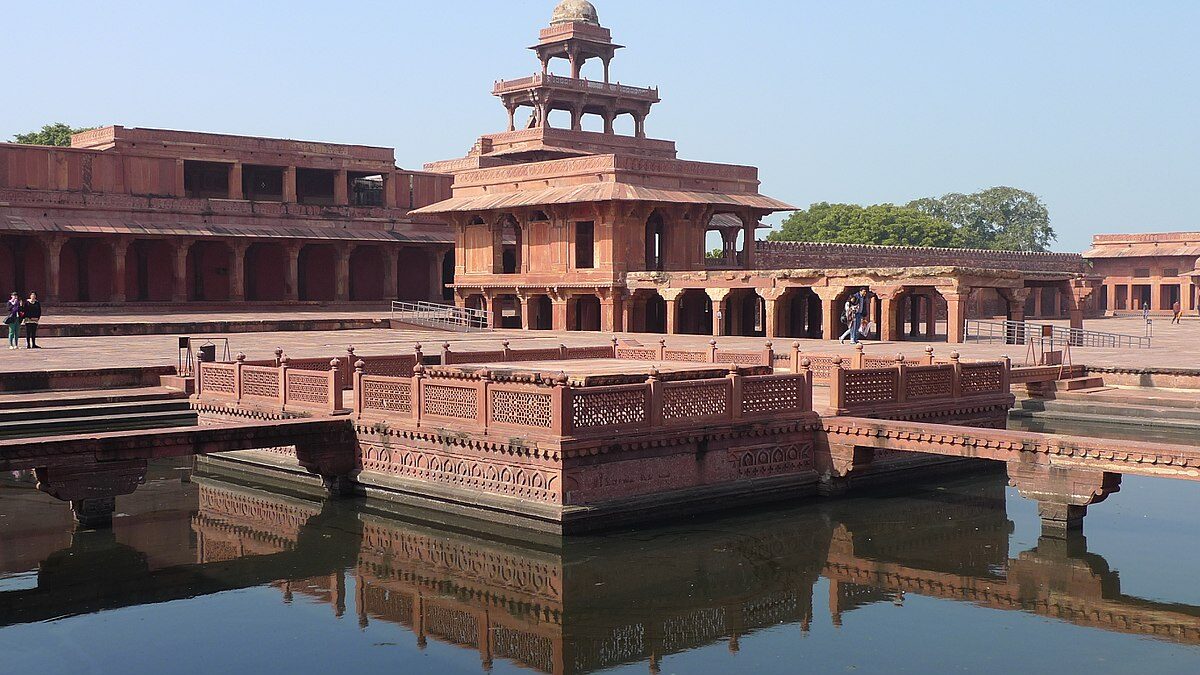Fatehpur Sikri is today an abandoned town that is located just 35 km. from Agra, but centuries ago it was the Mughal capital and one of the most relevant places of this empire that dominated India.
The remains that must be seen today in Fatehpur Sikri give a glimpse of the grandeur of this former imperial capital which, for 14 years, was the nerve center and is still considered one of the most beautiful examples of a Mughal walled city , having been declared a World Heritage Site. Humanity by UNESCO in 1986.
A bit of history about Fatehpur Sikri

Built by order of Emperor Akbar, Fatehpur Sikri was completed in 1585 with the aim of making the city a demonstration of Mughal power at the time.
Akbar wanted to build a new capital and after asking the wise men in his court, they told him the exact place where the imposing construction should be located. The indicated place was Sikri.
And Sikri was the original name of the city until the name ‘ Fatehpur ‘ was added commemorating Akbar’s victory over Gujarat, leaving its final name Fatehpur Sikri or “ the City of Victory ”.
After 14 years in which Fatehpur Sikri was the nerve center of the Mughal empire and India, the city was abandoned almost suddenly and sentenced to oblivion.
One of the theories about this abandonment of Fatehpur Sikri talks about the supposed inability to get water here in times of drought.
Be that as it may, today it is a ghost town that recalls the great times of the Mughal empire and its emperor Akbar in India.
What to see in Fatehpur Sikri
There are several key and very interesting points to see in Fatehpur Sikri, although the mere fact of walking through an imperial city that is preserved almost as it was abandoned in the 16th century, is already impressive on its own.
It must be taken into account that the complex was divided (and is currently divided) into two zones: the civil and the religious.
Diwan-i-Aam
Right after the entrance, this large pavilion was the one that Akbar used for public audiences. The truth is that he had it well set up because going there and seeing the large garden area is quite pleasant and I imagine that it helped everyone feel welcome when they arrived at Fatehpur Sikri. I don’t know if everyone would be equally happy.
Diwan-i-Khas
The pavilion for private audiences, the one used by the emperor to receive the most influential people who came to the city. On an aesthetic level, it is one of the most beautiful points to see in Fatehpur Sikri, with its sculpted columns supporting a beautiful two-story structure flanked by four imposing towers.
panch mahal
The Panch Mahal is another of the most beautiful buildings in the city, with five floors that decrease in size as they rise from the ground and a base supported by columns. As a consequence of its great height, this building was also known as the ‘ Tower of the Winds’ , which served to withstand the high temperatures of the area in summer.
In theory, this is where the emperor’s throne was located and although we didn’t check all of them, it is said that each of the 184 columns found among all the floors are different from each other.
House of the Turkish Sultana
This is undoubtedly the most beautiful stay in Fatehpur Sikri. Inside it is said that his favorite wife lived and it is incredible to see the level of detail of the carvings on its columns, walls and ceilings. Honestly, I too would choose this little stay for my best wife.
Buland Dawaza, the imperial gate
Already in the religious part of Fatehpur Sikri, the Buland Dawaza gate is huge. Its 54 meters high make it the highest in the world and crossing through it to access the main courtyard of the Jama Masjid, the city’s mosque, takes you back in time.
Jama Masjid, the great mosque of Fatehpur Sikri
Beautifull. The construction is similar to the one we have already seen in New Delhi, although somewhat smaller and today it is still used as a place of worship for Muslims.Inside the complex is also the Tomb of Salim Chishti , one of Akbar’s great trusted men and built entirely of white marble.
Hiran minaret
Now I find it surprising how many people come to Fatehpur Sikri and ignore the Hiran Minaret . It is a little further away, leaving the city itself and crossing a large gate that marks this limit, but this large tower with embedded white stones seemed to me to be the most beautiful and interesting thing to see in Fatehpur Sikri.
The reason for these elongated stones embedded in the tower? It is said that these stones simulate elephant tusks and Akbar, an elephant lover, had it made to remember his favourite.
Therefore, the Hiran minaret is also known as the Elephant Tower. So you can visit to this city Agra India to explore this.


